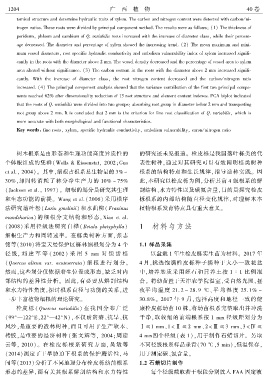Page 149 - 《广西植物》2020年第8期
P. 149
1 2 0 4 广 西 植 物 40 卷
tomical structure and determine hydraulic traits of xylem. The carbon and nitrogen content were detected with carbon/ ni ̄
trogen ratios. These roots were divided by principal component method. The results were as follows: (1) The thickness of
peridermꎬ phloem and cambium of Q. variabilis roots increased with the increase of diameter classꎬ while their percent ̄
age decreased. The diameter and percentage of xylem showed the increasing trend. (2) The mean maximum and mini ̄
mum vessel diametersꎬ root specific hydraulic conductivity and embolism vulnerability index of xylem increased signifi ̄
cantly in the roots with the diameter above 2 mm. The vessel density decreased and the percentage of vessel area to xylem
area altered without significance. (3) The carbon content in the roots with the diameter above 2 mm increased signifi ̄
cantly. With the increase of diameter classꎬ the root nitrogen content decreased and the carbon/ nitrogen ratio
increased. (4) The principal component analysis showed that the variance contribution of the first two principal compo ̄
nents reached 62% after dimensionality reduction of 13 root structure and element content indexes. PCA biplot indicated
that the roots of Q. variabilis were divided into two groups: absorbing root group in diameter below 2 mm and transporting
root group above 2 mm. It is concluded that 2 mm is the criterion for fine root classification of Q. variabilisꎬ which is
more accurate with both morphological and functional characteristics.
Key words: fine rootsꎬ xylemꎬ specific hydraulic conductivityꎬ embolism vulnerabilityꎬ caron/ nitrogen ratio
树木根系是由形态和生理功能高度异质性的 的研究还未见报道ꎮ 栓皮栎是我国落叶栎类的代
个体根组成的集群( Wells & Eissenstatꎬ 2002ꎻGuo 表性树种ꎬ通过对其研究可以有效阐明栎类树种
et al.ꎬ 2004)ꎮ 其中ꎬ细根占根系总生物量的 3% ~ 根系的结构特点和生长规律ꎬ指导造林实践ꎮ 因
30%ꎬ却周转消耗了林分净生产力的 10% ~ 75% 此ꎬ本研究以栓皮栎为例ꎬ分析其前 4 级根系的解
( Jackson et al.ꎬ 1997)ꎮ 细根的划分是研究其生理 剖结构、水力特性以及碳氮含量ꎬ目的是探究栓皮
和生态功能的前提ꎮ Wang et al.(2006) 采用根序 栎根系的内部结构随直径变化规律ꎬ对理解木本
法研究落叶松( Larix gmelinii) 和水曲柳( Fraxinus 植物根系发育特点具有重大意义ꎮ
mandshurica) 的细根分支结构和形态ꎬXiao et al.
(2008) 采用径级法研究白桦( Betula platyphylla) 1 材料与方法
细根生产力和周转速率ꎮ 在栎类树种方面ꎬ张志
铭等(2010)将宝天曼保护区栎林细根划分为 4 个 1.1 样品采集
径 级ꎬ 刘 建 军 等 ( 2002 ) 采 用 5 mm 对 锐 齿 栎 以盆栽 1 年生栓皮栎实生苗为材料ꎮ 2017 年
(Quercus aliena var. acuteserrata) 细 根 进 行 划 分ꎮ 4 月ꎬ挑选饱满栓皮栎种子播种于大小一致花盆
然而ꎬ这些划分仅依据着生位置或形态ꎬ缺乏对内 中ꎬ培养基质采用蛭石和营养土按 1 ∶ 1 比例混
部结构的差异性分析ꎮ 因此ꎬ有必要从解剖结构 合ꎮ 将幼苗置于天津农学院温室ꎬ受自然光照ꎬ昼
和水力特性角度ꎬ探讨根系直径与功能的关系ꎬ进 夜平 均 温 度 21. 2 ~ 28. 9 ℃ 、 平 均 湿 度 25. 1% ~
一步丰富植物细根的理论研究ꎮ 30.8%ꎮ 2017 年 9 月ꎬ选择高度和地径一致的健
栓皮 栎 ( Quercus variabilis) 在 我 国 分 布 广 泛 康栓皮栎幼苗 10 株ꎬ将幼苗根系完整取出并冲洗
(99°—122°Eꎬ22°—42°N)ꎬ不仅耐贫瘠、抗旱、抗 干净ꎬ取较细的前端根系按 1 mm 径级距划分为
风沙ꎬ是重要的造林树种ꎬ而且可用于生产软木、 Ⅰ≤1 mm、1 < Ⅱ ≤2 mm、2 < Ⅲ ≤3 mm、3 < Ⅳ ≤
栲胶ꎬ是重要的经济树种( 张文辉等ꎬ 2004ꎻ周建 4 mm四个径级( 表 1)ꎬ用于制作石蜡切片ꎮ 另取
云等ꎬ 2010)ꎮ 在 栓 皮 栎 根 系 研 究 方 面ꎬ 吴 敏 等 不同径级根系样品杀青(70 ℃ ꎬ5 min)ꎬ低温保存ꎬ
(2014)测定了干旱胁迫下根系的保护酶活性ꎬ马 用于测定碳、氮含量ꎮ
闯等(2013)分析了不同地理分布栓皮栎幼苗根系 1.2 石蜡切片制作
形态的差异ꎬ而有关其根系解剖结构和水力特性 每个径级截取若干根段分别放入 FAA 固定液

